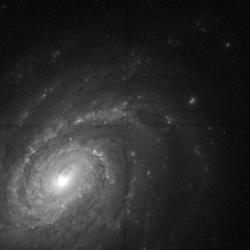Astronomy:NGC 214
| NGC 214 | |
|---|---|
 HST image of NGC 214 | |
| Observation data (J2000 epoch) | |
| Constellation | Andromeda |
| Right ascension | 00h 41m 28.02246s[1] |
| Declination | +25° 29′ 57.8430″[1] |
| Redshift | 0.015134[2] |
| Helio radial velocity | 4,555 km/s[3] |
| Distance | 193.8 Mly (59.43 Mpc)[3] |
| Apparent magnitude (V) | 12.97[2] |
| Characteristics | |
| Type | SABbc[4] |
| Apparent size (V) | 1.9' × 1.4'[2] |
| Other designations | |
| UGC 438, MCG +04-02-044, IRAS 00387+2513, F00388+2513,[5] CGCG 479-059, 2MASX J00412801+2529576, 2MASXi J0041280+252957, PGC 2479.[2] | |
NGC 214 is a spiral galaxy in the northern constellation of Andromeda, located at a distance of 194 megalight-years from the Milky Way.[3] It was discovered on September 10, 1784 by William Herschel.[6] The shape of this galaxy is given by its morphological classification of SABbc,[4] which indicates a weak bar-like structure (SAB) at the core and moderate to loosely-wound spiral arms (bc).
On July 19, 2005, a magnitude 17.4 supernova was detected at a position 16″ west and 2″ north of the galactic nucleus. The object was not visible on plates taken July 2, so it likely erupted after that date.[7] Designated SN 2005db, it was determined to be a type IIn supernova based on the spectrum.[8] A second supernova event was spotted from an image taken August 30, 2006, at 43″ west and 11.3″ south of the nucleus. It reached magnitude 17.8 and was designated SN 2006ep.[9] This was determined to be a type-Ib/c supernova.[10]
References
- ↑ 1.0 1.1 Brown, A. G. A. (August 2018). "Gaia Data Release 2: Summary of the contents and survey properties". Astronomy & Astrophysics 616: A1. doi:10.1051/0004-6361/201833051. Bibcode: 2018A&A...616A...1G. Gaia DR2 record for this source at VizieR.
- ↑ 2.0 2.1 2.2 2.3 "NASA/IPAC Extragalactic Database". Results for NGC 0214. http://ned.ipac.caltech.edu/cgi-bin/objsearch?objname=NGC+214&extend=no&hconst=73&omegam=0.27&omegav=0.73&corr_z=1&out_csys=Equatorial&out_equinox=J2000.0&obj_sort=RA+or+Longitude&of=pre_text&zv_breaker=30000.0&list_limit=5&img_stamp=YES.
- ↑ 3.0 3.1 3.2 Tully, R. Brent et al. (2016). "Cosmicflows-3". The Astronomical Journal 152 (2): 50. doi:10.3847/0004-6256/152/2/50. Bibcode: 2016AJ....152...50T.
- ↑ 4.0 4.1 García-Lorenzo, B. et al. (January 2015). "Ionized gas kinematics of galaxies in the CALIFA survey. I. Velocity fields, kinematic parameters of the dominant component, and presence of kinematically distinct gaseous systems". Astronomy & Astrophysics 573: 43. doi:10.1051/0004-6361/201423485. A59. Bibcode: 2015A&A...573A..59G.
- ↑ "NGC 214". SIMBAD. Centre de données astronomiques de Strasbourg. http://simbad.u-strasbg.fr/simbad/sim-basic?Ident=NGC+214.
- ↑ "New General Catalog Objects: NGC 200 - 249". Cseligman. http://cseligman.com/text/atlas/ngc2.htm#214.
- ↑ Monard, L. A. G. (July 2005). Green, D. W. E.. ed. "Supernova 2005db in NGC 214". Central Bureau Electronic Telegrams 182: 1. Bibcode: 2005CBET..182....1M.
- ↑ Blanc, N. et al. (July 2005). Green, D. W. E.. ed. "Supernova 2005db in NGC 214". Central Bureau Electronic Telegrams 183: 1. Bibcode: 2005CBET..183....1B.
- ↑ Joubert, N. et al. (August 2006). Green, D. W. E.. ed. "Supernova 2006ep in NGC 214". Central Bureau Electronic Telegrams 609: 1. Bibcode: 2006CBET..609....1J.
- ↑ Joubert, N. et al. (September 2006). Green, D. W. E.. ed. "Supernovae 2006ep, 2006eq, 2006er". IAU Circular 8744: 2. Bibcode: 2006IAUC.8744....2J.
External links
 |

